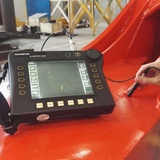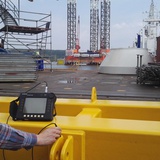Eddy current testing (ET) detects inconsistencies in electrically conductive materials, like ferritic steels, austenitic steels, non-ferrous alloys. Typical objects for ET are bars, wires, pipes, rails, axes of railway elements. Welded joints may be also examined for detecting surface welding imperfections, such as cracks, lack of fusion, lack of penetration, porosity, etc. Greatest advantages of this method are possibility of examination through paint coating, high sensitivity and reliability of detection and the ability of examination in hard-to-reach areas.

Application
We usually use ET in the operation stage when the coatings are in good condition. If indications are found, the eddy current testing often expands to other NDT methods.
For non-ferromagnetic materials such as aluminum, high alloy steels and small thicknesses (<5mm), it is possible to measure thickness by eddy currents.

Important to know
The maximum thickness of the non-ferromagnetic coating for ET is 2 mm. Conductive coatings, such as zinc coating, prevent eddy current testing.
